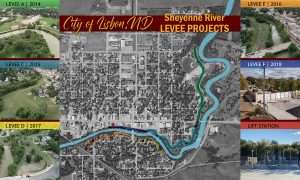
Flood Protection Project Alleviates Burden on Residences, Local Businesses
Residents of Lisbon, N.D., have been abuzz with anticipation lately about some encouraging changes on the horizon. As of November 16, a number of Lisbon residences and businesses that have always been considered within the floodplain will no longer be federally required to carry flood insurance. This is all thanks to a comprehensive levee project that began in 2014. The five new levees, floodwalls and three lift stations protect the city from the 1 percent (100-year) flood event as set forth by the Federal Emergency Management Agency (FEMA) in their Flood Insurance Rate Maps.
We recently commemorated FEMA’s acceptance of the Letter of Map Revision (LOMR) with representatives from the City of Lisbon. The ribbon cutting was a celebration of the community’s resilience, their commitment to investing in their future and the promise of permanent protection from future flooding.
So, how did we get here?
What would happen if your home started flooding? You’d take emergency precautions to block any more water from coming in by sandbagging or haphazardly throwing together a temporary structure made of whatever you could get your hands on. When the emergency is over, you’d look for more permanent solutions to prevent this from ever happening again, such as redirecting water away from your home or investing in some new landscaping.
That is exactly how the City and residents of Lisbon, also known as “A Place to Call Home,” responded to three consecutive annual flooding events in 2009, 2010 and 2011. As a major tributary of the Red River of the North, the Sheyenne River runs directly through the middle of Lisbon. In those three years, its crests surpassed the major flood level threshold of 19 feet reaching 22.86 feet, 19.46 feet and 21.58 feet, respectively.
The city and residents responded by constructing emergency levees along the river, successfully preventing significant damage in the moment. However, existing city streets and infrastructure began to fail against the heavy construction traffic required to build and disassemble emergency levees. In addition, the financial strain on the city and its residents forced the city to postpone two phases of a desperately needed sewer and water infrastructure replacement project.
The situation was unsustainable and it was clear that a permanent solution was needed.
In particular, there were four separate locations throughout the city where the riverbank was experiencing failures and threatening public infrastructure. The banks were extremely steep and falling into the river. Eventually, the flood project was broken up into separate phases and identified by a letter naming convention. The City prioritized three levee construction areas (A, C and E) and during the progress of the project added new levees (D, F and phase 2 of C and E).
Permits for the project required extensive coordination and application to a number of different agencies. Federal permits were obtained from the US Army Corps of Engineers and state permits were secured from the ND State Water Commission and ND State Transportation Department.
For a city in North Dakota with a population of about 2,000 people this $23 million project was a significant undertaking. Since the project was not previously included in the City’s capital planning, funding resources and grant options were extremely important. Multiple sources of funding included:
- Primary funding grants came from the North Dakota State Water Commission.
- Loans were obtained through the Bank of North Dakota and North Dakota State Revolving Loan Fund.
- The City of Lisbon funded the remaining portion with existing budgeted funds, sales tax increases and special assessments.
Congratulations to the City of Lisbon!

